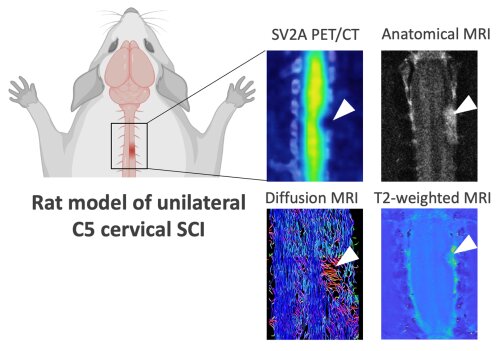Study of Neuroplasticity after Spinal Cord Injury locally and in the brain
Traumatic spinal cord injury (SCI) is a devastating condition characterized by long-term motor and sensory neurological deficits. Although emerging therapeutic strategies focused on functional recovery after SCI are being explored, their development and translation to clinical use are severely limited by the lack of functional, objective, and noninvasive in vivo imaging biomarkers related to pathophysiological processes, thus reflecting the underlying SCI damage, functional outcome, and repair mechanisms.
We want to establish synaptic and white matter integrity changes, two key pathophysiological hallmarks of SCI, as in vivo biomarkers for monitoring and predicting SCI outcomes. Accurate quantitative imaging biomarkers would facilitate the interpretation of therapeutic results in preclinical studies, ensuring a faster translation of promising new treatment strategies to patients with SCI. We apply state-of-the-art MRI and synaptic PET neuroimaging in a longitudinal multimodal approach to visualize and quantify synaptic and white matter integrity over time in a clinically relevant cervical contusion rat model of SCI.

Following SCI, the entire central nervous system experiences increased neuroplasticity levels over several months as the spinal cord attempts to stabilize itself, meaning that most of the recovery occurs within the first year after their SCI. Emerging therapeutic strategies focused on neuromodulator approaches (including epidural or transcranial stimulation, opto- or chemogenetics, and brainmachine interface) to restore function after SCI are in development. The idea behind these approaches is to stimulate specific spared pathways between the brain and spinal cord to facilitate activitydependent plasticity, thus, ultimately, improving functional recovery. In the era of precision medicine, the ability to visualize and quantify the spatiotemporal changes occurring in the brain following SCI represents an extremely powerful approach toward patient-specific neuromodulation. Therefore, we aim to develop non-invasive in vivo brain imaging approaches to visualize functional and structural plasticity occurring in the brain following SCI.